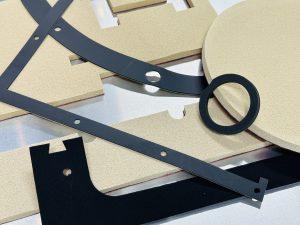Gaskets are essential components when sealing gaps, dampening vibration, and preventing leaks. From aerospace components to industrial equipment, gaskets are incorporated to prevent failures and improve product function. This guide shares our expertise in designing the right gasketing solution for your application.
Benefits

- Prevents Leaks: Provides ingress and/or egress prevention for fluids, gases, or other substances.
- Increases Durability: Withstands extreme conditions, helping equipment last longer and perform better under stress.
- Reduces Costs: Minimizes downtime, repairs, and replacements costs by preventing damage due to leaks or malfunctioning seals.
- Absorbs Vibrations: Helps reduce vibrations and noise, improving the overall operation of machinery.
- Fits Specific Applications: Designed with materials that match the exact conditions of the application, from high temperatures to chemical exposure.
- Protects Against Contamination: Shields equipment from contaminants and corrosion, maintaining cleanliness and operational integrity.
- Boosts Safety: Reduces risks by keeping hazardous substances contained and ensuring safer working environments.
Types of Gaskets
When selecting gaskets, it’s important to understand the key types commonly used in various applications. Here are three main types:
Flat gaskets
Frequently squeezed to form a tight seal that prevents fluids or gases from passing between two surfaces. Foam and rubber materials are the most common materials used in manufacturing flat gaskets. Typically produced by cutting via tool, laser, or other fabrication processes.

Composite gaskets
Utilizing a mix of materials to enhance performance and meet specific sealing needs. Engineered to combine the best properties of each material, these gaskets can offer improved chemical and temperature resistance, along with enhanced mechanical strength. Composite materials can include the combining of metal and plastics with foams, rubbers, and even thin films.

O-rings
An excellent option for high-pressure applications. Capable of resisting up to 5,000 PSI while preventing the escape of liquids or gases. Ideal for sealing cylindrical-shaped components, such as pipes or hoses. Most O-rings are made from elastomeric materials with a round cross-section produced through an extrusion or molding process.

Common Gasket Materials
1. Nitrile Rubber (NBR)
- Resistant to petroleum-based oils and fuels, as well as to water and alcohol. The material is also durable and flexible.
- Common uses: Automotive, aerospace, and general-purpose sealing.
2. Fluorocarbon (Viton®)
- Resistance to chemicals, petroleum products, and temperatures up to 400°F.
- Common Uses: Chemical processing, automotive, and aerospace industries.
3. Silicone
- Excellent temperature performance and flame resistance.
- Common Uses: Transportation, medical devices, and high-temperature sealing.
4. EPDM (Ethylene Propylene Diene Monomer)
- High resistance against water, ozone, steam, and certain chemicals. Not suitable for petroleum-based oils.
- Common Uses: Water systems, automotive cooling systems, and outdoor applications.
5. Neoprene
- Excellent resistance to aging, weathering, ozone, and oils.
- Common Uses: Refrigeration systems, automotive, and industrial applications.
6. Polyurethane
- Excellent compression set resistance, good chemical resistance, flame rated to UL94, a wide range of thicknesses and densities.
- Common Uses: Sealing, energy absorption, and vibration/sound dampening.
7. Buna-N (a type of NBR)
- Extremely resilient type of nitrile rubber resistant to oils, gasoline, and other petroleum-based compounds. Provides good resistance against abrasion.
- Common Uses: Fuel systems, oil handling, and general-purpose sealing.
Material & Application Considerations
- Gasket Purpose and Environment: Define the gasket’s function and the conditions it will face, such as temperature, pressure, chemicals, and ingress.
- Material Selection: Choose the right material based on the environment and specific needs.
- Performance Criteria: Ensure the gasket meets essential properties like firmness (shore, durometer, density), compression set, temperature, closed cell / open cell / solid.
- Gasket Type: Determine which gasket is best based on the specifics of your application. Flat, Composite, or O-Ring.
Processes of Manufacturing Gaskets:
Various manufacturing techniques can be utilized in the production of gaskets. Selecting the right process requires careful consideration of specifications, production volumes, and budget. Here are some general guidelines for the options to manufacture the different types of gaskets:
- Steel Rule Diecutting: A cost-effective option for medium to high production volumes to cut parts to size.
- Tolerance can vary significantly based on material thickness, durometer/shore, and part size.
- Tool cost is more economical than Class A tooling.
- Ideal for materials that are either thinner or softer.
- Digital Cutting: Best suited for lower volume production.
- Processes include laser cutting, router/drag-knife cutting, and waterjet.
- Excellent tolerance performance regardless of material thickness, durometer/shore, and part size.
- Can be cost-prohibitive at higher volumes due to the slower processing speeds as compared to cutting with a tool.
- Class A Tooling: Ideal for high volume, tighter tolerance production.
- Excellent tolerance performance regardless of material thickness, durometer/shore, and part size.
- Higher tool cost and significantly longer lead time than steel rule die.
- Ideal for tighter tolerance, complex geometry, and higher volume parts.
- Compression/Injection Molding: Best for higher volume where part design allows for no other option.
- Best tolerance performance of all tooling.
- Tool cost is significant and lead time can be many weeks.
- Ideal for tighter tolerance, complex geometry, and higher volume parts that cannot be produced via Class A tooling.
- Limited material options.
Selecting the right materials and avoiding common errors during manufacturing are key to successful gasket design. Gaskets play a crucial role in sealing gaps, preventing leaks, and enhancing the performance and safety of equipment in various industries.
By understanding the benefits, types, key design considerations, and processing options, you’ll be well-prepared to choose the right manufacturer and ensure your gasket solutions perform reliably and meet your requirements.

